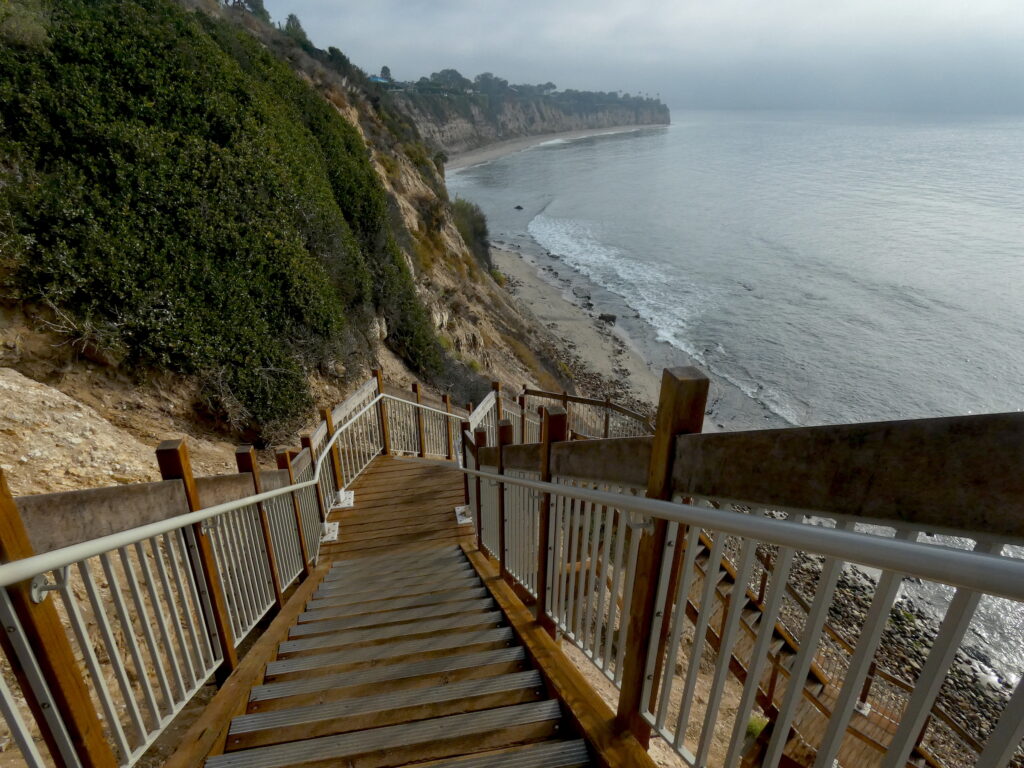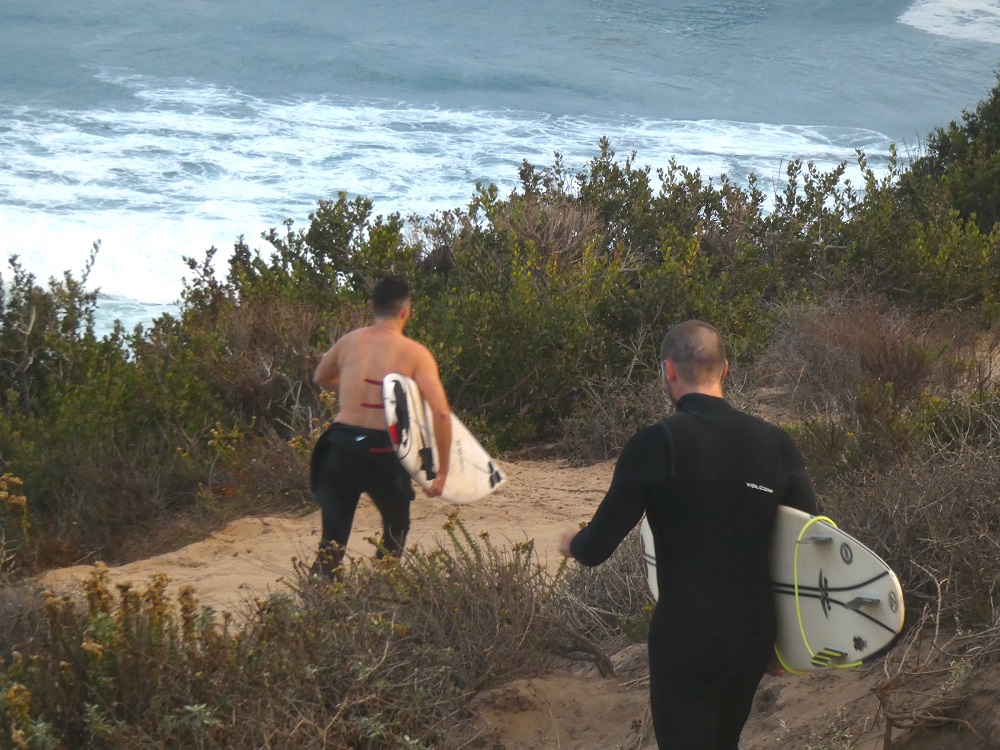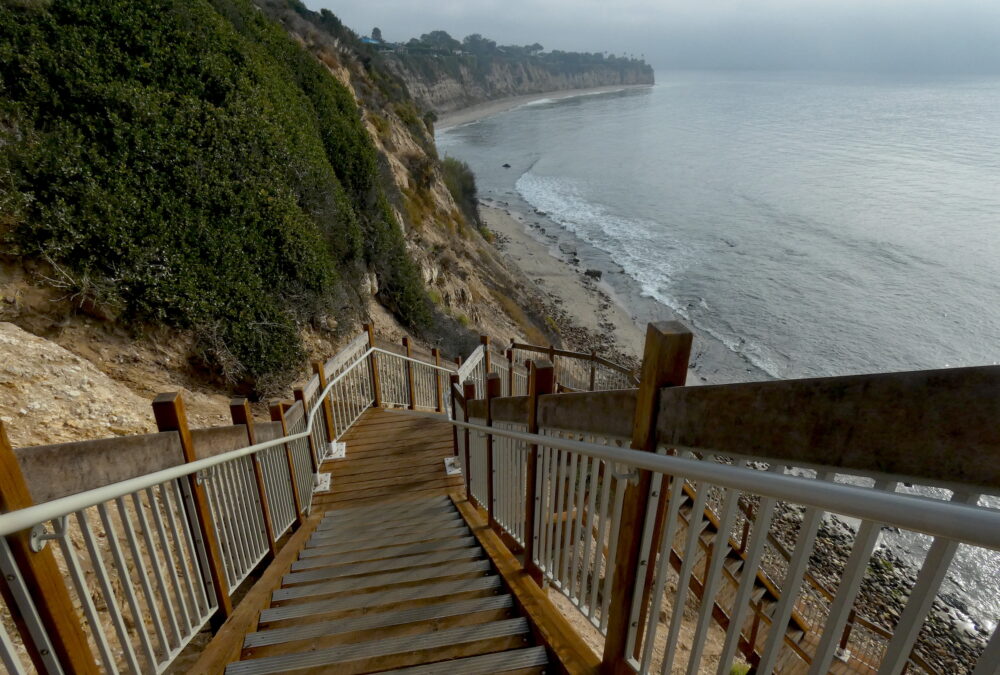
The new stairway at Point Dume State Beach had a soft opening this month. This long-awaited beach accessway replaces an older staircase built in the 1990s that was unsafe after years of punishing environmental conditions and high levels of use. The difference between the old stairs and the new is dramatic.
The new staircase was a formidable engineering feat. The steps—more than 100 of them—cascade down the side of the cliff, supported on massive caissons, and interspersed with a series of landings. The cliffs here are fragile, unstable, and environmentally sensitive, making this project a challenge to build. The stairs provide walkers with a stellar view of the coast and the cliff from the various landings, and this is in many ways a new view, one that no one has ever had the opportunity to see before.
Construction on the new stairs began in 2020, but the $3.3 million project was delayed by the coronavirus pandemic. Now, the new access way is fully open, although part of the nearby trail remains closed for restoration and revegetation.
The new stairs lead down to the beach in Big Dume Cove. Unfortunately, there isn’t much beach right now and the stairs currently end amid the rocks at the edge of the intertidal zone. Low tide is definitely the time to visit, but care is strongly recommended. This is a wild stretch of coast, with no amenities, and getting medical aid to the bottom of the cliff is a challenge.
This isn’t a route for people who suffer from acrophobia, or who have knee problems or other mobility disabilities—ADA parking is readily available at the main Westward Beach parking lot, below and to the west of the Point, and a gravel path and wooden boardwalk offer an easy walk to a whale watching platform with benches and a stellar view, The new staircase is, however, a welcome addition for hearty beach walkers, and especially to surfers, who have been using a precarious—and completely unsanctioned—cliffside rope to access the beach during the replacement project.

At low tide, the new staircase offers access to pristine and beautiful Big Dume Cove, at high tide there is no place to go except back up the stairs. This is a wild, scenic and potentially dangerous stretch of coast, with many submerged rocks and no lifeguard. It’s perfect for walkers and for experienced surfers, but better and safer options for swimming can be found at Westward and Zuma.
The tide pools in the area are protected, no collecting or fishing is allowed, but there is plenty to see here. Keep an eye out for the things that make this place so special, including peregrine falcons, ospreys, California brown pelicans, Western snowy plovers, California sea lions, and Malibu’s much loved bottle-nose dolphins. However, the most important thing to watch for is the tide. Getting caught on the rocks or in one of the smaller coves is a real hazard on this stretch of coast, and cell phone reception is limited.
The Nature Preserve is small but offers several walking options: a section of the newly named Poppy Trail is currently closed for rehabilitation and revegetation. Coreopsis Loop Trail encircles the flat-topped hill at the center of the park, and includes a fairly easy to access boardwalk to a whale watching platform—watch for broken boards. However, the portion that runs around the southern side of the promontory, while dramatic, is extremely rocky. Sturdy shoes are recommended. Side routes go up to the top of the point, offering 360-degree views of the ocean and mountains, and down to the parking lot at Westward. This is one park where staying on the designated path is essential. The bluffs have an incredibly fragile ecosystem, and geology is unstable, making it a good idea to stay a safe distance from the cliff edge.
Spring, when the giant coreopsis is in bloom and there is a good chance of spotting migrating gray whales, is the most spectacular time to visit this small but extraordinary park, but Point Dume State Park and Natural Preserve offers rare beauty all year round.
Street parking near the Point Dume Natural Preserve is extremely limited, but there is ample free parking on Westward Beach Road, and pay parking in the lot at the end of the road. For more information, visit: https://www.parks.ca.gov





